
Article and all photos by Joe Mock, BaseballParks.com
All rights reserved
MADISON, ALABAMA Quick, what do the following teams have in common with the first-year Rocket City Trash Pandas? Omaha Storm Chasers; Round Rock Express; Las Vegas Aviators; Sacramento RiverCats; Arkansas Travelers; Tennessee Smokies; Hillsboro Hops; Augusta GreenJackets.
| Ballpark Stats |
 |
| Team: Rocket City Trash Pandas of the Double-A South League |
| First game: May 11, 2021, a 4-3 loss to Tennessee |
| Capacity: 7,500 |
| Dimensions: LF – 326; LCF – 385; CF – 400; RCF – 375; RF – 326. |
| Architect: Populous: Jason Michael Ford, Project Manager; Mike Sabatini, Project Designer; Josh Vogel, Project Architect |
| Construction: Hoar and Turner |
| Price: $46 million |
| Home dugout: 1B side |
| Field points: East by southeast |
| Playing surface: Bluegrass overseeded with Bermudagrass |
| Naming rights: purchased by Toyota for three years, with two options |
| Ticket info: www.milb.com/rocket-city/tickets/ |
| Betcha didn’t know: Until a two-story restaurant is built in left field, there will be an odd elevator shaft protruding high above the main concourse |
Give up? They all play in a ballpark built by a suburb of a much larger city. In each case, the bigger city wouldn’t build a new park for a Minor League team badly in need of one, but the more progressive – and smaller – suburb came up with a way to make it happen.
When the Omaha Royals were being booted out of Rosenblatt Stadium, Sarpy County built them a new park, and they became the Omaha Storm Chasers. Austin shunned multiple attempts to bring pro baseball to town, but the northern suburb of Round Rock built the Dell Diamond. The city proper of Las Vegas refused to build a new stadium for the 81s, so the developer of the unincorporated suburb of Summerlin built a world-class ballpark and the team became the Las Vegas Aviators. This is also the case with West Sacramento, the Tennessee County of Sevier, the Portland suburb of Hillsboro, and North Augusta.
So when a group of investors that goes by the name BallCorps LLC purchased the Southern League’s Mobile Bay Bears, they negotiated a deal with the Huntsville suburb of Madison to build what is today called Toyota Field (the car manufacturer has a plant in Huntsville). That’s where the Rocket City Trash Pandas now play.
You know something else interesting about those teams above? Most of them elected not to adopt the suburb’s name as its geographic designation, with most (you could make the case that it’s seven of the nine) opting to use the city name of the larger neighbor.
And North Augusta is in a different state (South Carolina), but still they use the location designation of Augusta.
So even though the city of Madison, Alabama made Toyota Field happen, the team held a contest to allow the fans to choose the geographic designation. “Rocket City” – because of the area’s longtime association with the space industry – was the runaway winner, ahead of “North Alabama.” “Madison” finished a distant third.
So where did the colorful nickname of Trash Pandas come from? If you guessed that it won a Name The Team contest, you’d be correct. And it won it by a mile, more than doubling ThunderSharks and tripling Moon Possums. Bringing up the rear were two names I would’ve preferred over the top three vote getters: Space Chimps and Comet Jockeys. My desire to tie into the outer-space theme shows why I write about sports facilities rather than operate a pro team.
What is a Trash Panda you ask? It really doesn’t have anything to do with space (although there was a reference to “trash pandas” in Guardians of the Galaxy), although the very clever designers at Brandiose dressed up the logo with a rocket-ship look. No, “trash panda” is slang for a raccoon. To quote Brandiose, “no creature in our galaxy is as smart, creative, determined and ingenious a problem-solver as our local raccoons!”
| The Woeful Joe |
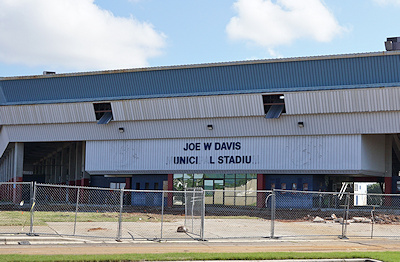 |
| Huntsville lost affiliated baseball when its Southern League Stars moved to Biloxi in 2015. The reason? Joe Davis Stadium in Huntsville was simply awful, and no replacement was in sight. Here’s what it looked like (it appears that its long-needed demolition is happening) as the Trash Pandas started playing just eight miles away in Madison. |
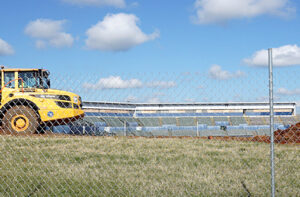 |
So the logo shows a determined raccoon emerging from a rocket-powered trash can. Of course. (It’s shown on a cap in our Ballpark Stats box.)
And when “Sod Poodles” carried the day when Amarillo needed a team nickname, you figured Trash Pandas would be the winner in Madison (there is also an interesting design element of Toyota Field borrowed from Amarillo’s park – more on that later). In fact, Brandiose reports that voting for Madison’s team’s name was the largest community participation in such a contest in Minor League Baseball history – by far.
How popular has the nickname been? Since the nickname was announced in September 2018, Trash Panda merchandise topped $1 million by May 2019 (remember, the team was still in Mobile at the time), $2 million by December 2019, and by Opening Day of the 2021 season, $4 million.
Think about that. $4 million before the team had played a single game.
“Having the name Trash Pandas allows us to have a lot of fun and have a cute mascot,” Lindsey Knupp, the team’s VP of Marketing, Promotions and Entertainment, told us. “For instance, at the gates on opening night, we had a drumline playing songs on trash cans. Originally, some people were concerned about the word ‘trash’ being in the nickname, but it’s a commonly used word, and young people find it fun and kind of tongue-in-cheek.”
“There are so many plays possible on the words ‘trash pandas’ for concessions, merchandise and more,” the team’s Executive Vice President and GM Garrett Fahrmann said. “The YouTube channel Smarter Every Day asked us to partner with their experiment called Supersonic Baseball to see what happens to a baseball that reaches the speed of sound. So we supplied him with the baseballs with our logo on one side and Smarter Every Day on the other. He devised a cannon to fire a baseball at over 1,000 miles per hour, and filmed it hitting a steel wall. That video has been viewed over 11 million times.
“There are a lot of engineers living near here and if this appeals to them, then great!”
If you want to watch that YouTube video, here it is.
While the team was busy filling merchandise orders and watching 1,000 MPH balls in 2020, it would’ve preferred to be playing baseball games. With the arrival of 2021, Toyota Field is now hosting the National Pastime, and local fans are excited.
But what is Toyota Field like? Let’s take a closer look at where it is, what it looks like, and what the atmosphere is like at a Trash Pandas game.
The Setting
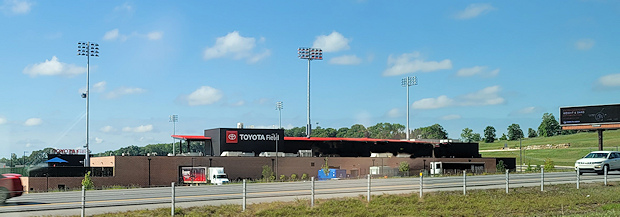
Madison, Alabama is a suburb to the west of Huntsville. In fact, as Huntsville has annexed more and more land, it now surrounds Madison on the north, east and south.
The population of the entire metro area is approaching half a million, with Huntsville accounting for 202,000 and Madison 51,000.
Madison is certainly an affluent suburb, with an average household income of about $115,000, nearly doubling the same measurement in Huntsville. So Madison, with lots of residents working in aerospace and military positions, had the means to build a new ballpark, while Huntsville didn’t.
In fact, Huntsville had a Double-A team as recently as 2014, when the Stars fled one of the worst ballparks in affiliated baseball to a new facility in Biloxi, Mississippi. Had Huntsville built a new ballpark, that franchise most likely would’ve stayed put. There was nothing wrong with the market. It was the ballpark that stunk.

The baseball-less void is what opened the door for the Bay Bears to move to Madison.
Its city limits stretch for about four miles north of Interstate-565, but less than two miles to the south. It is in this sliver of land on the south side of the highway where the development known as Town Madison is taking root. The housing subdivisions already built and under construction here and just to the south are very upscale. It’s also noteworthy that a large rock quarry is less than a half mile to the southwest. More on this later.
The Breland Companies assembled about 500 acres along the south edge of I-565, and sat on it until the ideal time for development came along. That development is Town Madison.
With no pro baseball in the Huntsville area, BallCorps struck up conversations with Madison.
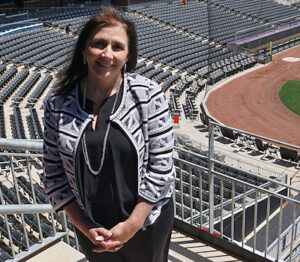 “The developer was in the process of attracting users to Town Madison,” Mary Beth Broeren (see photo), Director of Development Services for the city, told us. “Along the way, BallCorps approached us to see if we were interested in having a Double-A baseball team, and at the time there was no plan to have an attraction like this park in the development. We were intrigued, and Breland became interested because having a baseball stadium would be a natural fit” for Town Madison.
“The developer was in the process of attracting users to Town Madison,” Mary Beth Broeren (see photo), Director of Development Services for the city, told us. “Along the way, BallCorps approached us to see if we were interested in having a Double-A baseball team, and at the time there was no plan to have an attraction like this park in the development. We were intrigued, and Breland became interested because having a baseball stadium would be a natural fit” for Town Madison.
Soon international sports-architecture heavyweights Populous were brought into the discussions to assess how a park could be incorporated within the 500 acres. Breland did their assessment, Madison did theirs and BallCorps did theirs. The result was that Populous was soon designing what became Toyota Field.
So what surrounds the ballpark now that it’s open? Well, a new interchange is half-finished directly adjacent to the Toyota Field, linking eastbound I-565 with the 2,000 parking spaces adjacent to the park. It opened four days prior to opening night. The problem is that the corresponding ramp allowing westbound traffic to access the park has yet to be built, as does a flyover ramp to put people leaving the park onto westbound I-565. Instead, fans wanting to head that way following a game have to drive the length of the development on Town Madison Blvd to a left on Zierdt Road, then under the Interstate to a left on Madison Blvd, drive a mile back west to get on I-535 at Sullivan Street.
Not ideal, especially since it will be at least a year and a half before the flyover will be built, according to Broeren.
The proximity of the park to I-565 provides tremendous visibility for the facility (see the photo at the top of this section), a fact on which the Trash Pandas capitalized by running ads on the changeable billboards between the park’s exterior and the highway. At night, the ballpark’s huge video board in right field shines like a beacon to those going westbound on 565.
As for Town Madison, not a lot is completed as the ballpark opened – as evidenced by the cleared-but-not-built-on parcels extending several blocks down Stadium Way beyond the left field wall. On the other side of that street is a set of lovely apartments called The Station. In between those apartments and the park’s centerfield will be a Marriott, as the chain has already signed on the dotted line. A second boutique hotel may be built beyond right-centerfield.
The undeveloped parcels are slated to be restaurants, shops and perhaps more residential units.
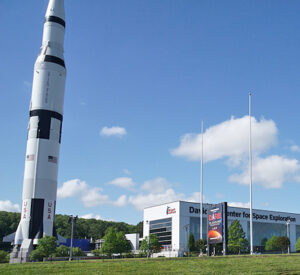
So this is a work in progress, but given the desirability of businesses – and frankly residents – establishing homes in an upscale community like Madison along a busy Interstate, I have little doubt that Town Madison will be quite a success for Breland.
I have equally little doubt that the Trash Pandas’ tenure here will be quite fruitful. Everything about this location screams “success.” Redstone Arsenal almost abuts the southern city limits of Madison. Over 30,000 people work there – and many do professional work such as engineering and aeronautics, fields that pay well. Also consider that the center of Huntsville is only 10 miles from the ballpark, plus tourist magnet the U.S. Space & Rocket Center (see photo) – with its cute street address of 1 Tranquility Base – is a scant six miles straight up I-565. The Center, home to the famous Space Camp, was drawing 850,000 visitors a year pre-COVID, making it the biggest tourist attraction in Alabama.
The Exterior
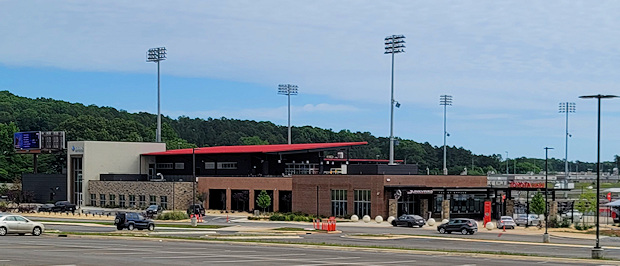
One of my favorite aspects of Toyota Field is its color scheme — but only on the interior. On the inside, the shades mimic the corporate colors of Toyota, with a bright red roof and black on the upper side walls.
I don’t have the same enthusiasm for the exterior.
As we mentioned, the north side of the park’s exterior is quite visible to passing highway traffic, but fans attending games aren’t likely to see it up close. That’s because when a fan walks from his car to an entryway – whether in the main lot on the west side of the park or down Stadium Way beyond the outfield – there’s no way for them to walk past this area. Commercial deliveries are made along this side of the park, by the way.
Directly behind home plate is an opening on the main-concourse, but the second story here is completely built out. Populous’ Lead Designer on the project Mike Sabatini explains that this was done to allow more light and air into the seating bowl. This creates an intriguing view from the outside almost all the way to the field. Outside a perimeter fence here is a grassy area with nice landscaping with room for a couple of picnic tables.
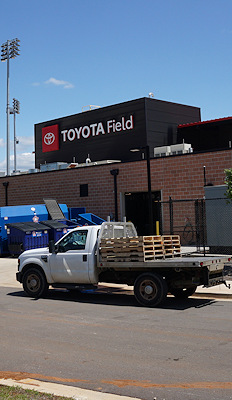  |
| The first shot above is of the north side of the exterior, where few fans will venture. The other shot shows the area directly behind home plate. |
The main effort on the exterior, though, is reserved for the area behind roughly the first-base dugout all the way down to the entry gates by the right-field foul pole. There is a really dark metal building material behind, say, the on-deck circle, and a much lighter masonry around the two-story entryway called the Trustmark VIP Entry. This is where suiteholders can enter, and where you access the team offices. To the right of that is the exterior of the team offices, and it features a mixture of brownish-hued blocks. Next is the outside of indoor batting cages, and it’s surrounded by red brick. Next to it is the structure that holds the team store and ticket windows, and it is a different shade of brick. Next to it is the park’s main entryway, called the Pepsi Gate. It has black wrought-iron fencing around it.
OK, if you’ve paid any attention to the previous paragraph, you’ve noted that this is a lot of different colors, and a lot of different building materials, including brick, stone, metal and something called concrete masonry units. Each area is perfectly fine in its own right, but to me, it’s too many competing looks all in a row. “Some of the shades we used were inspired by the exposed rock of the nearby quarry, plus the differences in color and material represent the different varieties of people who are going to be using the facility,” explains Sabatini.
The outer perimeter around the outfield is similar iron fencing to that around the Pepsi Gate. There is a gate in that fencing in dead centerfield. It was locked on opening night, but was utilized with a metal-detector and ticket takers for the second night. In the long run, this will be a much-used entry.
I get the impression that this outer fence can be moved if necessary, if the developments around it need to encroach on some of this space, or if the team wants to add more programming elements out there. Almost assuredly a two-story restaurant or brew-pub will be built near the leftfield corner of the park … as one of the interior design elements of Toyota Field provides a big – or should I say tall – clue.
So let’s venture inside this impressive ballpark.